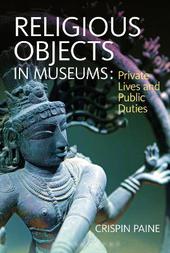
|
Religious Objects in Museums: Private Lives and Public Duties
Paperback / softback
Main Details
| Title |
Religious Objects in Museums: Private Lives and Public Duties
|
| Authors and Contributors |
By (author) Crispin Paine
|
| Physical Properties |
| Format:Paperback / softback | | Pages:176 | | Dimensions(mm): Height 234,Width 156 |
|
| Category/Genre | Art History
Religion and beliefs |
|---|
| ISBN/Barcode |
9781847887733
|
| Classifications | Dewey:200.75 |
|---|
| Audience | | Tertiary Education (US: College) | |
|---|
|
Publishing Details |
| Publisher |
Bloomsbury Publishing PLC
|
| Imprint |
Berg Publishers
|
| Publication Date |
17 January 2013 |
| Publication Country |
United Kingdom
|
Description
In the past, museums often changed the meaning of icons or statues of deities from sacred to aesthetic, or used them to declare the superiority of Western society, or simply as cultural and historical evidence. The last generation has seen faith groups demanding to control 'their' objects, and curators recognising that objects can only be understood within their original religious context. In recent years there has been an explosion of interest in the role religion plays in museums, with major exhibitions highlighting the religious as well as the historical nature of objects.Using examples from all over the world, Religious Objects in Museums is the first book to examine how religious objects are transformed when they enter the museum, and how they affect curators and visitors. It examines the full range of meanings that religious objects may bear - as scientific specimen, sacred icon, work of art, or historical record. Showing how objects may be used to argue a point, tell a story or promote a cause, may be worshipped, ignored, or seen as dangerous or unlucky, this highly accessible book is an essential introduction to the subject.
Author Biography
Crispin Paine is an editor of Material Religion: the Journal of Objects, Art and Religion.
ReviewsThis excellent study of museum exhibitions of religiously significant objects provides an illuminating overview of the issues and challenges arising from such exhibitions...Crispin Paine's book is a welcome new resource and will appeal to all who seek to understand the material dimensions of religious activity. * Journal of the American Academy of Religion * Very readable book around the different ways in which religious objects are experienced in museums ... Paine has spent time gathering a rich collection of anecdotes, literature, and exhibition episodes that allow him to construe a lively sense of the differing parties that make up the museum experience today around the world. * Journal of Contemporary Religion * The comprehensive bibliography offers abundant resources for additional study. Overall, the volume is highly readable and desirable for museum professionals, museum studies students, and those interested in exploring new ways to consider questions of identity, display, and stewardship. * Museum Anthropology * [This book] is a valuable tool for scholars interested in this topic, since it provides an overview on the main issues surrounding religious objects and helps us think about how they are displayed and experienced ... Researchers on material culture will find intriguing cues for reflection ... It will also interest museum and heritage specialists dealing with issues of preservation and dissemination of cultural heritage policies. More broadly, this volume will inspire scholars from a number of disciplines dealing with human-object interactions studies. * Current Anthropology * In this wide-ranging study, Crispin Paine shares his observations on how museums worldwide present religious objects ... [He] has evidently travelled widely and read deeply in order to research the subject ... Paine it so be congratulated on achieving the first publication to tackle such a wide-ranging subject. * Art and Christianity * The author takes his readers on a magical world tour of tangible things that were once-and in some cases still are-used in a huge variety of religious settings. With a cosmopolitan lightness of touch, Paine demonstrates the radical instability of such things, even once they have found their way into museums. They do not have a single meaning or use, but are almost infinitely adaptable. Above all, he deftly shows that the "distinction between 'religious' and 'mundane' is a curious modern Western idea, incomprehensible to most people at most times." No other book introduces readers more engagingly to the puzzles surrounding how museums address the sacred realm worldwide. * Ivan Gaskell, Professor of Cultural History, and of Museum Studies, Bard Graduate Center, New York City *
|